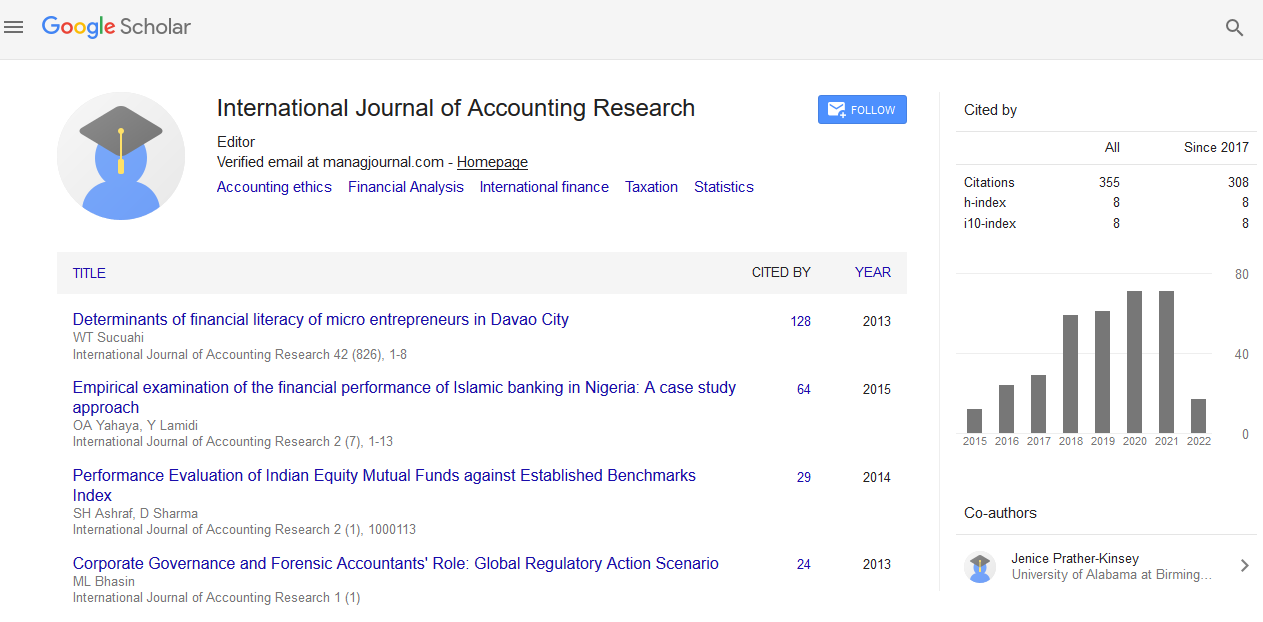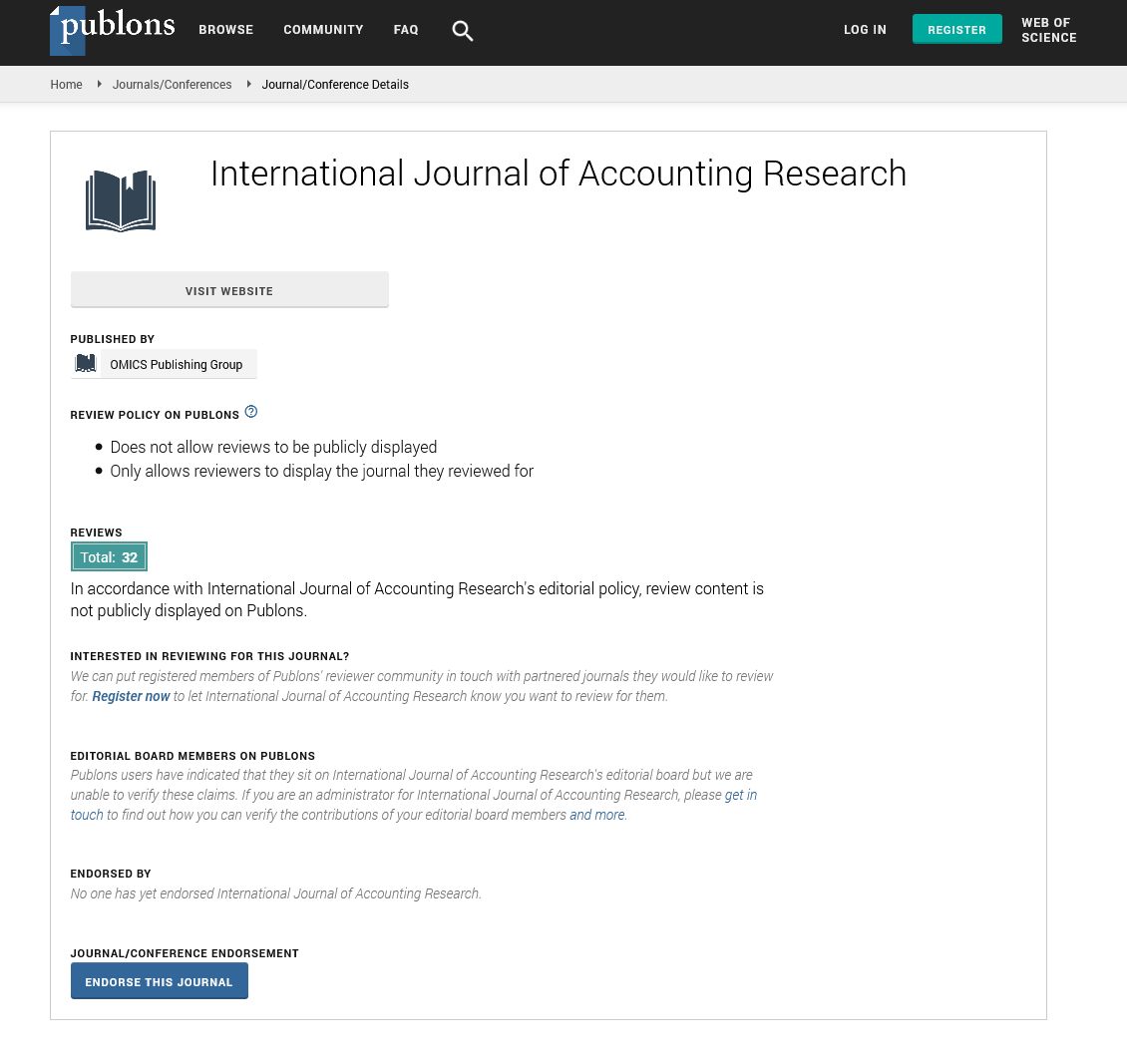Indexed In
- Open J Gate
- RefSeek
- Hamdard University
- EBSCO A-Z
- Scholarsteer
- Publons
- Euro Pub
- Google Scholar
Useful Links
Share This Page
Journal Flyer

Open Access Journals
- Agri and Aquaculture
- Biochemistry
- Bioinformatics & Systems Biology
- Business & Management
- Chemistry
- Clinical Sciences
- Engineering
- Food & Nutrition
- General Science
- Genetics & Molecular Biology
- Immunology & Microbiology
- Medical Sciences
- Neuroscience & Psychology
- Nursing & Health Care
- Pharmaceutical Sciences
Perspective - (2022) Volume 10, Issue 6
Forensic Accounting: Importance and its Applications
Yang Kueno*Received: 02-Jun-2022, Manuscript No. IJAR-22-17238; Editor assigned: 06-Jun-2022, Pre QC No. IJAR-22-17238 (PQ); Reviewed: 20-Jun-2022, QC No. IJAR-22-17238; Revised: 30-Jun-2022, Manuscript No. IJAR-22-17238 (R); Published: 07-Jul-2022, DOI: 10.35248/2472-114X. 22.10.277
Description
Investigative, accounting, auditing, and other abilities are used in forensic accounting to look into someone's or a company's financial situation. An accounting analysis suitable for use in court proceedings is provided by forensic accounting. To go beyond the numbers and deal with the situation's business reality, forensic accountants receive special training. In fraud and embezzlement prosecutions, forensic accounting is sometimes utilized to describe the specifics of a financial crime in court.
In-depth financial and business issues are analyzed, interpreted, and summarized by forensic accountants. They could work for public accounting firms, banks, police departments, insurance companies, or the government. Forensic accountants gather financial proof, create computer programs to manage the data gathered, and offer their conclusions in reports or presentations.
When calculating damages is necessary in a lawsuit, forensic accounting is used. The quantifications are used by the parties in legal disputes to aid in settlement negotiations or court rulings. For instance, disagreements over pay and benefits could lead to this. If the argument goes to court, the forensic accountant might be called as an expert witness.
In order to determine whether a crime took place and gauge the likelihood that it had malicious intent, forensic accounting is also used. Employee theft, securities fraud, information falsification in financial statements, identity theft, and insurance fraud are a few examples of such crimes. Investigations into construction claims, expropriations, product liability claims, or trademark or patent infringements are examples of forensic accounting tasks. To top it all off, forensic accounting can also be utilized to estimate the financial impact of a nondisclosure or non-compete agreement breach. Determining the amount the customer should want from the insurer is necessary for an insurance claim. A thorough examination of the insurance policy would be the first step to ascertain "coverage," or what is insured, as well as any provisions that would limit the amount that can be claimed or render the claim invalid.
To quantify the loss, or the amount to be claimed, the second stage would be to acquire evidence. Claims resulting from the misuse of assets, such as the theft of products or money, may be included in insurance claims. To balance the amounts possessed and ascertain the value of the products or cash stolen in such situations, the forensic accountant will examine inventory or cash records as well as specifics of sales and purchases. By counting a sample of current inventory or cash and comparing it to the client's records, they will also check the accuracy of the data held. The forensic accountant will not automatically presume that there has been a theft; instead, they will take into account various scenarios, such as a data error.
However, there are instances where insurance claims are far more difficult than this, such as when business interruptions result from a fire or flood. The forensic accountant will study anticipated financial data and compare it to reported results in these types of engagements to assess the profit loss brought on by the disruption of operations. The forensic accountant will take other factors into account, such as a simple loss of market share to a competitor, before assuming that there has been any loss of profit as a result of the business disruption.
The forensic accountant is frequently asked to estimate a loss in forensic engagements. One such engagement is dealing with accusations of professional negligence, or where another accountant has violated their duty of care to a client or third party and caused that client to suffer a loss. The forensic accountant would also offer an opinion on whether the duty of care due has been violated in these types of engagements, i.e., if the audit or other accounting service was carried out in accordance with current standards in practice, legislation, and procedures. This would necessitate taking into account whether the International Standards on Auditing were followed in regard to an audit.
When two parties cannot agree on the amount that one party owes another and the accountant is called in to provide an expert assessment, such as of a business, the need for a forensic accountant may also arise. In a divorce dispute, this could occur when a divorcing couple hires a forensic accountant to appraise the business in order to achieve a settlement. The couple's assets include shares in a corporation or partnership. When one partner wants to quit a partnership and is being bought out by the other partner, a similar procedure may be used.
Citation: Kueno Y (2022) Forensic Accounting: Importance and its Applications. Int J Account Res. 10:277.
Copyright: © 2022 Kueno Y. This is an open access article distributed under the terms of the Creative Commons Attribution License, which permits unrestricted use, distribution, and reproduction in any medium, provided the original author and source are credited.


